Literary Terms and Devices Made Simple: A High School Student’s Guide

Having a wide range of literary terms and definitions in your toolkit can help you write strong and convincing essays, engage critically with literary texts, and squeeze even more enjoyment out of your favourite novels and poems!
With this in mind, we’ve curated a helpful guide to introduce you to some key literary devices you might not have encountered in your day-to-day reading.
We’ll also run through some terms you’re likely already familiar with, but with helpful definitions and new ways of thinking about them.
What Are Literary Terms and Devices?
The great literary critic Harold Bloom once said that “reading well is one of the great pleasures that solitude can afford you,” but what exactly does he mean by “reading well”?
It’s not simply a case of reading widely or reading often – although both of these are also important! – but rather reading closely; understanding what a writer is aiming to do with their work, and how they’re doing it. The way we do this is by developing a solid knowledge of literary terms and devices, a specialised collection of words and phrases designed to better understand the English language.
Why Should High School Students Learn Literary Terms and Devices?
In developing a strong foundation in literary terms and devices, we can better understand not just the work we read, but the whole world around us.
I. Strategic exam preparation
Becoming familiar with different literary terms and devices, to the point where you can immediately notice them in a piece of writing, is one of the most effective tools you can have going into an English exam.
Tackling unseen texts in an exam can be quite intimidating, so knowing your assonance from your alliteration will help to keep those pre-exam nerves at bay. A wide literary-critical vocabulary will help you effectively demonstrate your understanding of a text in a timed-setting.
II. Elevated literary creativity
By understanding the tricks and techniques of the writers you study, you’ll soon find you’re able to employ them in your own writing, meaning you’ll be able to express yourself far more effectively in essays.
Understanding literary terms and devices can also be pretty inspiring, so don’t be surprised if you decide to put your new knowledge to the test in your own creative writing! Incorporating sophisticated literary devices into your work can elevate your writing to new heights.

III. Informal textual discussions
Having a wide literary vocabulary isn’t just helpful for written work. A class where students are able to discuss texts in a mature and sophisticated way is going to be far more engaging and valuable to you and your classmates.
Providing insightful observations in a classroom is also a great way of challenging yourself and fostering working relationships with teachers and fellow students, something which will be increasingly important as you head to university and beyond.
IV. Preparation for university
That’s right: learning literary terms and devices is a great way to get a head start on Arts and Humanities degrees like English Literature or Creative Writing.
Seminars are an exciting and challenging part of any literature degree. You’ll be discussing texts in detail with your peers, so coming equipped with a literary terms toolkit will be a huge advantage.
You’ll likely be expected to do lots of group work in university too, so contributing thoughtfully is essential. By engaging enthusiastically in literary discussions, before and during university, you’ll foster a life-long passion for debate and collaboration, and perhaps be inspired to pursue a career in an English-related field, like academia or publishing.
How Do I Learn Literary Terms and Devices?
Learning about literary terms and devices is exciting, but it can be a lot of work. After all, some professors dedicate their whole lives to learning and developing terminology.
You needn’t be intimidated though! There are plenty of techniques to help you learn lots about the world of literary criticism. Flashcards and quizzes, which you’re no doubt familiar with from revision in other subjects, are a great way of memorising new words and definitions. Study groups are another great way of developing your literary vocabulary, as well as for getting used to the kinds of discussions you can expect in university seminars.
Key English Terms for High School Students
Without further ado, let’s jump into some key terms!
Literary terms
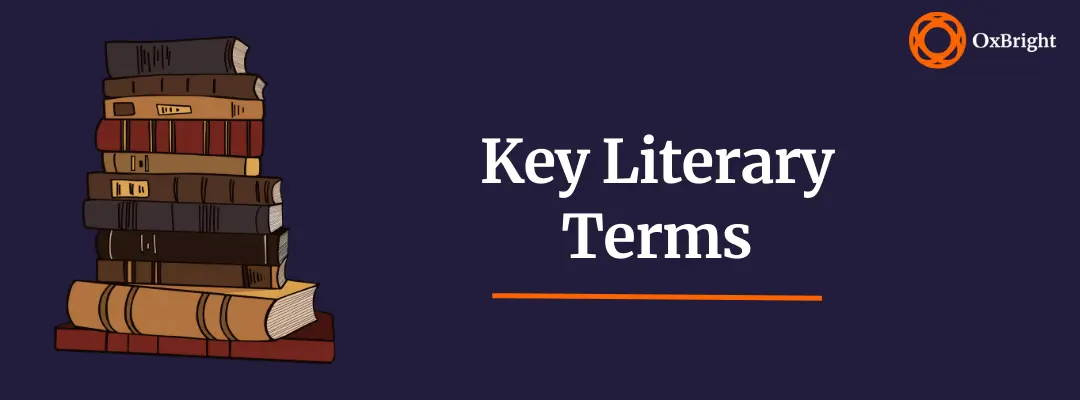
Key Literary Terms
Plot. A word you’re no doubt familiar with already, plot refers to the sequence of events that make up the storyline or narrative structure of a text. While it might seem like a simple term, plots can be complex, non-linear, or barely have a plot at all, so it’s always worth thinking about how plot functions in a literary work.
Genre. Another familiar term, and another loaded one! Genre refers to the style of a literary work, based on its form and content. We might initially think of only a small handful of different genres, like romance, fantasy and comedy. In fact, there’s a huge number of genres, from autofiction to Afrofuturism – and that’s just the letter “A”! Figuring out what genre (or genres!) a text fits into is often contentious, but always worth considering.
Setting. The setting of a text means the time and place in which a story unfolds. This can be the physical environment or historical period the text takes place in. Understanding setting helps us to consider a writer’s motives – why have they chosen this specific setting?
Context. The context of a literary work refers to the circumstances, background and conditions surrounding the text. This could be the cultural and historical setting the text was written in, or the author’s own background. Considering the context of a literary work helps us better understand the author’s intentions, as well as what the work might have meant for its original readers.
Characterisation. In literature, characterisation is the process of creating and developing the characters in a story. Character traits, motivations and relationships inform the work as a whole, particularly if the narrative is first person, so understanding characterisation is an important part of unlocking a text.
Theme. A theme refers to the central idea or underlying message conveyed by a work. Two readers might read the same novel or poem and detect two completely different themes. This is great though, and is really what literary criticism is all about: fostering debate and convincing others of your perspective!
Motif. A motif is very similar to a theme, but with a few key differences. Where themes are the central ideas and messages of a literary work, motifs are recurring elements that enhance the narrative and contribute to the impact of the theme.
Here’s an example: in George Orwell’s Animal Farm, you might argue that the theme of the novel is corruption, whereas a motif is the pigs’ gradual adoption of human behaviours. In other words, the motif gives us hints of the larger theme.
Imagery. Imagery refers to the use of vivid and descriptive language to evoke mental pictures for the reader. When you’re reading a literary work and you can picture certain characters, settings or events in your head, that means the writer is using imagery – and using it well!
Conflict. When you think of conflict in a novel, you may think of actual conflict between characters, but the literary definition of the term is far broader. A literary work can contain conflict between several different ideas, events or points-of-view. Some of the most interesting works of fiction contain conflict, and identifying contrasting elements can help to provide a more nuanced understanding of a text’s intended aims.
Resolution. With conflict often comes resolution. Resolution refers to the outcome of the central conflict in the story. It’s the point where the main problems within the text have been resolved and a sense of closure is created, but consider this: what’s a writer suggesting if a literary work doesn’t have resolution? What’s your reaction to this lack of closure?
Point-of-view. Point-of-view refers to the narrator’s perspective. A story being told from a particular point-of-view can influence the reader’s perception and understanding of the narrative. For example, we might consider a story told in the first-person to be more biased, and a story told in the third-person to be more trustworthy.
Considering the reliability of a text’s point-of-view is a huge – and rather interesting – can of worms. Do you trust that the narrator is reliably recounting events, or do they have their own, perhaps hidden, motives?
Tone. The tone of a text is essentially the author’s attitude or emotional expression toward their subject matter. It conveys the mood and atmosphere of a literary work.
Consider the opening line of Jane Austen’s Pride and Prejudice: “It is a truth universally acknowledged, that a single man in possession of a good fortune, must be in want of a wife.” Austen’s tone here is one of irony and wit. She is critiquing societal expectations of marriage. When we read this opening sentence we know to expect a novel which satirises social norms and relationships.
Mood. While similar to tone, the mood of a text primarily concerns the reader’s reaction. The mood of a novel is developed through setting, imagery and description.
Let’s now consider the opening line of F. Scott Fitzgerald’s The Great Gatsby: “Whenever you feel like criticising anyone, just remember that all the people in the world haven’t had the advantages that you’ve had.” Fitzgerald conveys a mood of contemplation here, in which the narrator is reflecting on a life lesson. He invites us, the reader, to contemplate it too.
Protagonist. Protagonist is essentially another word for the main character of a story. Whether it’s J.D. Salinger’s Holden Caulfield or Arthur Conan Doyle’s Sherlock Holmes, the protagonist of a text is the character whose journey or actions drive the story forward.
Antagonist. As you might have guessed, an antagonist acts in opposition to a protagonist, but take note: protagonist and antagonist don’t simply mean “good guy” and “bad guy”. The protagonist of a novel might be a heinous individual, while the antagonist might be the moral voice of reason.
Consider the title character of Macbeth, who becomes consumed by ambition and commits bloody murder. Now he is without a doubt the protagonist of Shakespeare’s famous play, but he’s hardly a good guy!
Literary devices
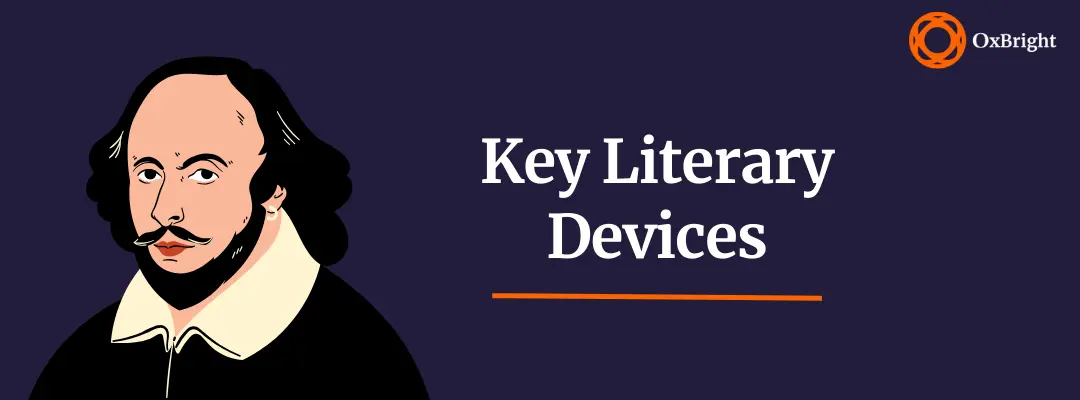
Key Literary Devices
Clause. Think of a clause as a building block for a sentence. A clause generally includes a subject (who or what the sentence is about) and a predicate (what the subject is doing, or the action taking place). A clause could be as simple as: “Harry goes to the shops”.
Semantic field. A semantic field refers to a group of words or expressions that are related in meaning and revolve around a central concept. For example, words such as “green”, “leafy”, “breeze” and “river” are all part of a semantic field of nature. This group of words will evoke a particular feeling or setting, and will inform the writing’s tone and mood.
Foreshadowing. When a literary work uses foreshadowing, it subtly implies the events or themes that are going to crop up later in the text. The use of foreshadowing in literature is a great reason to read things twice (or even more times), as you’ll often miss foreshadowing on the first go through.
Exposition. Exposition refers to the part of a literary work that introduces crucial background information, providing details about the setting, characters or conflict. Exposition gives readers the necessary context to understand the rest of the text.
Trope. In literature, a trope refers to a commonly used theme, motif or literary device. For example, a trope of Gothic literature might be a dilapidated or haunted setting, such as a creepy castle or an eerie graveyard. Sometimes literary tropes can have negative connotations, as they suggest an unoriginal piece of work, but often tropes are helpful in comparing multiple texts.
Stream of consciousness. Stream of consciousness writing is a narrative technique that presents the uninterrupted flow of a character’s thoughts and feelings in an entirely unfiltered manner – much like the real life thoughts in our own heads, which are rarely neatly organised and structured.
Juxtaposition. Juxtaposition refers to the placement of two contrasting elements, such as characters, settings or themes. For example, take the proverb “you can’t teach an old dog new tricks”. Here, the “old dog” and the “new tricks” are two opposing ideas placed side-by-side.
Repetition. In literature, much like in general conversation, repetition can be used to emphasise a certain point. Whether it’s specific words, or even entire sentences, repetition often makes us reconsider our initial opinion. Consider how meaning can change when words are repeated, and why an author might want to emphasise these particular words.
Antithesis. Antithesis is a literary device where contrasting ideas, words or phrases are placed in close proximity to highlight their difference. Unlike juxtaposition, antithesis focuses on a formal, structured opposition between two things.
One of the most famous examples of antithesis comes from the opening line of Charles Dickens’ A Tale of Two Cities: “It was the best of times, it was the worst of times, it was the age of wisdom, it was the age of foolishness…”
Irony. When a writer uses irony in literature, they’re trying to highlight a discrepancy between what is said and what is meant, between what is expected and what actually happens, or between appearance and reality. This contrast can have effects ranging from humour to biting social critique.
Rhetoric. Rhetoric refers to the technique of using language to persuade, influence or convey ideas. It involves the strategic use of words, phrases and many of the literary devices mentioned above to effectively communicate an idea or belief. When we write essays, we employ rhetoric.
Chiasmus. This fancy word refers to a phrase which is immediately followed by its reverse. One of the most famous examples of chiasmus can be found in John F. Kennedy’s famous declaration: “Ask not what your country can do for you; ask what you can do for your country.” When done well, chiasmus can be very memorable and profound.
Anaphora. Anaphora is a rhetorical device which involves the repetition of a phrase at the beginning of several successive clauses or sentences. A famous example of anaphora can be found in Bob Dylan’s famous song Blowin’ in the Wind: “How many roads must a man walk down before you call him a man? How many seas must a white dove sail before she sleeps in the sand?”
Epistrophe. Much like anaphora, epistrophe refers to the repetition of words or phrases but at the end of a clause or sentence. Bob Dylan’s Blowin’ in the Wind once again provides a perfect example: “The answer, my friend, is blowin’ in the wind. The answer is blowin’ in the wind.”
Allegory. When a story contains an allegory, it means that its characters or story contain a hidden meaning. This deeper, allegorical meaning will often be a moral story, one in which the specific events of the text have a wider, universal meaning. The famous story of the hare and the tortoise is an allegory.
Paradox. In literature, a paradox is a statement or a situation that appears contradictory. Paradox can be a powerful tool for a writer who wants to demonstrate the complexity and nuance of the subject they’re writing about.
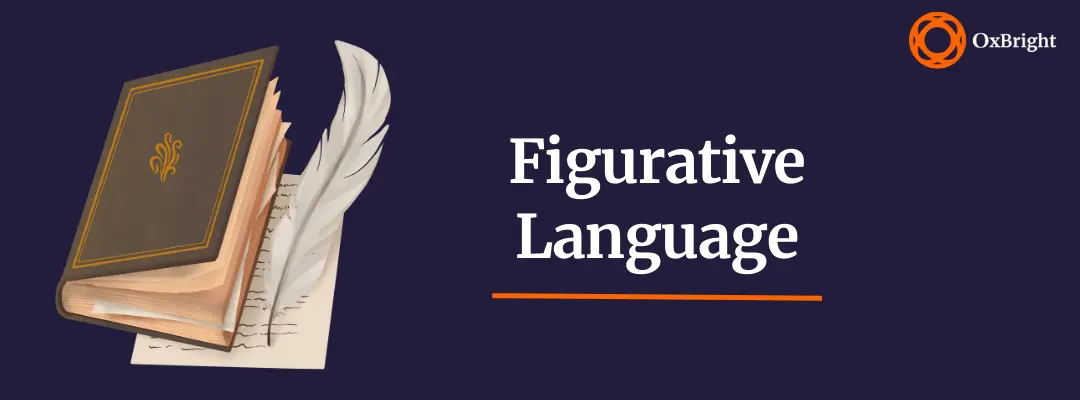
Figurative Language
Simile. A simile is a figure of speech that compares two separate things using the words “as” or “like”. For example, “she was as fast as a cheetah”.
Idiom. An idiom is a figure of speech with a meaning that extends beyond the literal interpretation of the words. For example, often when someone says “bite the bullet”, they in fact mean “go for it”.
Metaphor. Much like a simile, a metaphor involves comparing one thing to another. However, unlike a simile, a metaphor will actually state that one thing is another, for dramatic effect. For example, “my essay is a mountain of work”.
Personification. Personification is when an author gives human attributes to a non-human entity, like an animal or object. Here’s an example: “the wind whispered through the trees.”
Hyperbole. When a writer uses hyperbole, it means they’re exaggerating for dramatic effect. Hyperbole can make a piece of literature scarier, funnier or generally larger than life.
Alliteration. Alliteration refers to the repetition of words that begin with the same letter, either several times within the same sentence, or one word after another. Alliteration is commonly found in poetry to add a more rhythmic, musical quality to the writing.
Assonance. Assonance is the repetition of vowel sounds within a sentence, or one word after another. It can be used to create a similar effect to alliteration in poetry or in prose.
Symbolism. When a writer uses symbolism, they’re using an element of their writing – a character, setting or object, etc. – to represent something else. Like allegory, the use of symbolism can elevate a text and give it a more universal meaning.
Onomatopoeia. Onomatopoeia (pronounced ono-ma-toh-pee-ya) refers to words which imitate the actual sound they describe. For example, “hiss”, “buzz” or “crash”.
Allusion. Allusion is a subtle and indirect reference to a particular thing, be that a person, place or event – perhaps even another literary work. By reading widely, you’ll build a vast bank of knowledge, and will soon be able to spot even very sneaky allusions!
Oxymoron. An oxymoron combines opposing words to create a paradox. Examples include “deafening silence” and “living dead”.
Pun. No doubt you’ve heard puns in everyday conversations – or in Christmas crackers (dads are particularly fond of them)! A pun is a form of wordplay that plays on multiple meanings or sounds of a word.
What do penguins wear on their heads? Ice caps… Sorry.
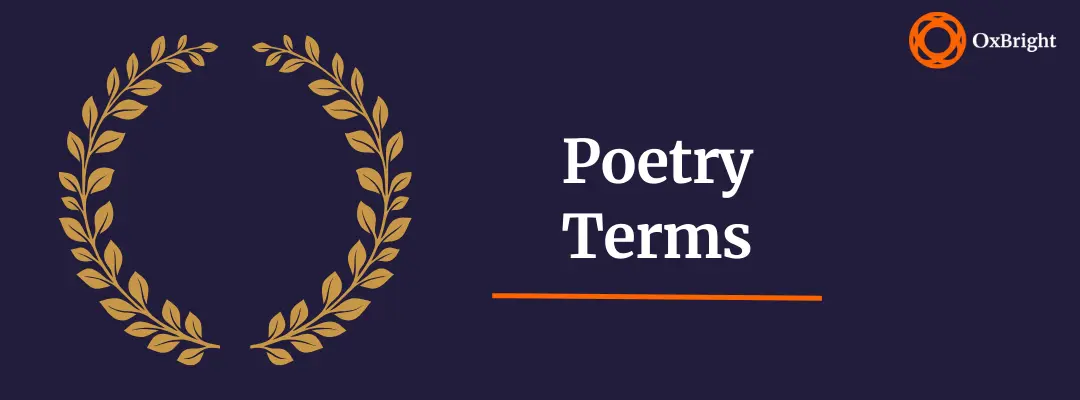
Poetry Terms
Metre. In poetry, metre refers to the rhythmic structure of a verse. The metre of a poem determines its musicality, and depends on the amount of stressed (emphasised) and unstressed (un-emphasised) syllables in a line.
Rhyme. Rhyme refers to the correspondence between sounds at the end of two words. Most commonly, poets will rhyme the end of one line with the next, but they can also rhyme the first line with the third line, or rhyme words in the middle of two corresponding lines. There are a number of different possible combinations – the opportunities are pretty much endless.
Enjambment. This very fancy word refers to the continuation of a sentence beyond the end of one line of poetry and into the next one, without any pause or punctuation. This allows a poem to flow in a less conventional way, and can add a dynamic, rhythmical quality to a piece of poetry.
Caesura. Somewhat the opposite of enjambment, caesura is a deliberate pause within a line of poetry, usually created with the use of punctuation. This can create a dramatic effect in a poem, deviating from our expectations in an exciting way.
Sonnet. A timeless poetic form, a sonnet consists of 14 lines. There are a number of different types of sonnets, from the Petrarchan to the Shakespearean, each with its own unique rhyme scheme.
Volta. Many sonnets contain a volta, a kind of plot-twist that occurs midway through the sonnet, changing the overall tone of the poem. Volta is an Italian word meaning “turn”.
Haiku. A haiku is a traditional form of Japanese poetry consisting of three lines: five syllables in the first, seven in the second, and five in the third. Haikus are one of the most simple and impactful poetic forms, so why not have a go at writing one yourself!
Elegy. Elegies are poems which express sorrow and mourning, usually for someone who has died. Though their forms and rhyme schemes can vary, some of the most famous and beautiful poetry ever written has been in elegy form. We recommend Alfred, Lord Tennyson’s In Memoriam as a good starting point.
Couplet. A couplet refers to two lines of poetry, one after the other. By studying two lines side-by-side we can interpret their relationship and their joint significance.
Stanza. A stanza is the grouping of several lines of poetry separated by spaces, much like a paragraph in a novel or an essay. Like couplets, it can be interesting to study a stanza in isolation to the rest of the poem. Consider why the poet has decided to separate one stanza from another, and how two or more stanzas complement or contradict one another. Stanza is another term we take from Italian, this time meaning “room”.
Iambic pentameter. Iambic pentameter is a type of poetic metre, and perhaps the world’s most famous. It consists of lines of ten syllables each, with a stress on every other syllable. William Shakespeare frequently used iambic pentameter in his plays and his sonnets, as did many Romantic poets such as Robert Browning and Percy Bysshe Shelley.
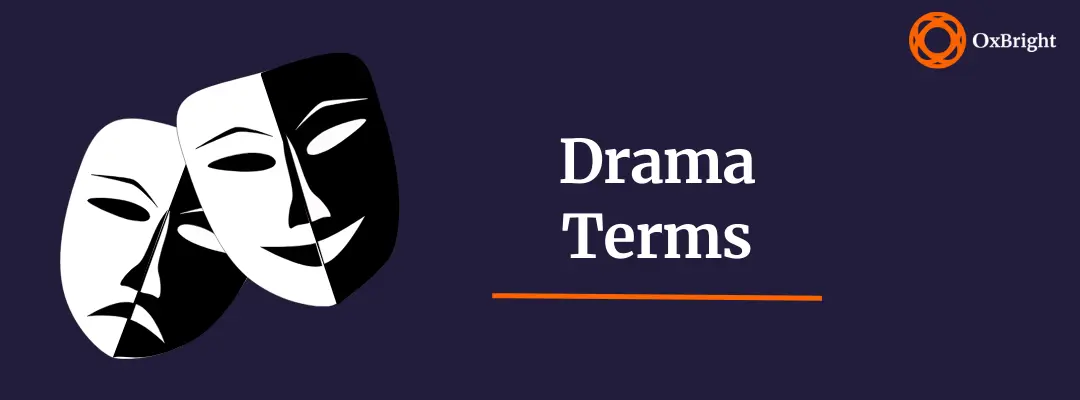
Drama Terms
Act. An act refers to a section of a play which contributes to the overall narrative. Many plays are separated into several acts, which are themselves separated into different scenes, although many playwrights have written one-act plays too. These tend to be shorter and more experimental.
Scene. Scenes are specific sections of a play, usually contained within acts, and are composed of dialogue and action. Transitions between scenes are often marked by changes in time, location or characters.
Monologue. A monologue is a speech or extended piece of dialogue delivered by a single character on stage. Often, monologues are used to convey a character’s thoughts and emotions, heightening the drama and intrigue of the play.
Soliloquy. A soliloquy is a dramatic monologue delivered by a character who is alone on stage. Unlike regular monologues, they reveal a character’s internal thoughts and feelings as though they are speaking to themselves (or to the audience). Think of them almost like a voiceover in a film.
Aside. An aside is a brief remark spoken by a character directly to the audience (or to another character) that isn’t intended to be heard by the rest of the characters on stage. Asides are a great way of incorporating humour into a play, and create a closer connection between audience and character.
Malapropism. A malapropism is a comedic device in which a character misuses or substitutes a word for a similar sounding one, resulting in an absurd statement. The term is derived from Richard Brinsley Sheridan’s play The Rivals, in which the character Mrs. Malaprop frequently misspoke.
Satire. In drama, satire can be either a genre or a literary device within a play. Satire is intended to criticise or mock people, behaviours or institutions through irony and exaggeration.
Oscar Wilde’s famous play, The Importance of Being Earnest, is a cutting satire of Victorian conformity. In Victorian England, social customs like marriage were seen as more important than pretty much anything else – an idea Wilde hoped to challenge in his writing.
Hopefully this article has helped introduce you to some key literary terms and devices, and you now know your motifs from your malapropisms!
Next time you sit down to read a play, a poem or a novel, think about which literary devices the writer is using and the effects of each technique. In almost no time, you’ll be using your newfound analytical skills to write intelligent, nuanced essays and begin in-depth class discussions.

By Sam Cox
Sam is a recent English graduate from the University of Bristol whose interests include twentieth-century fiction, film, and cultural criticism.
Recommended articles
OxBright Tutors Share Their Top Tips for High School Graduates
Finishing high school can be a really intimidating juncture – you’re leaving the security of a routine you’ve followed for five plus years, and you’re faced with more options and less structure than ever before. Oh, and your decisions now can shape your future in a...
Which Career Is the Best Fit for Me?
Choosing your career path is one of the first big steps you’ll take as a young adult, so it can often be a daunting prospect. However, the possibilities are endless, and as long as you base your choices on your personal preferences, passions and interests, your...
How to Make a Study Schedule That Actually Works
Studying can sometimes feel like a daunting task, no matter how old you are or what level you’re studying at. You might be left thinking: How can I balance academics with my other commitments? How do I stay consistent with a study schedule? Is there a “good” or...



